AVENGERS #54 (1968)
by Roy Thomas & John Buscema
I’ve been extremely critical of most of the Roy Thomas stories I’ve reviewed so far: I’m not fond of the way he writes dialogue, and some of his narrative choices can be questionable.
But there’s a bright spot: his run on the Avengers is historical to say the least!
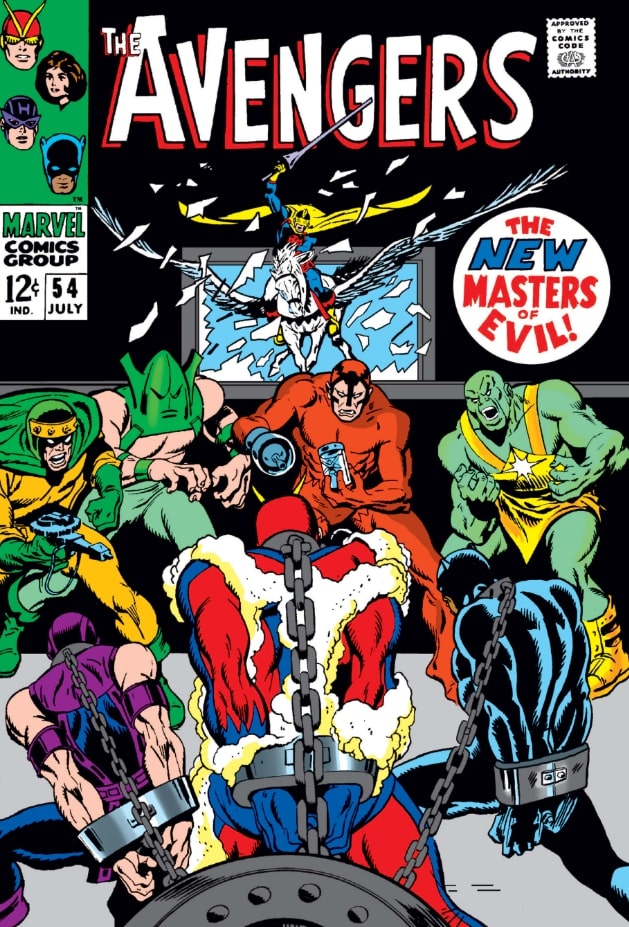
At the moment the team consists of Hank Pym (in his Goliath identity), Black Panther (in an awful variation of his costume), Wasp (in one of her weirdest costumes) and Hawkeye (the only one in his classic attire).

This run is one of the reasons why Jarvis, the Avengers butler, grew into a more important character. He had appeared before, sure, but this is the first time he’s given focus.

I’m not really fond of describing him as being “loaned” by Stark, though.

It’s easy today to think this is Jarvis acting out of character, but remember he didn’t have a ton of scenes before this, so it must’ve been easy to believe he really WOULD betray the Avengers.
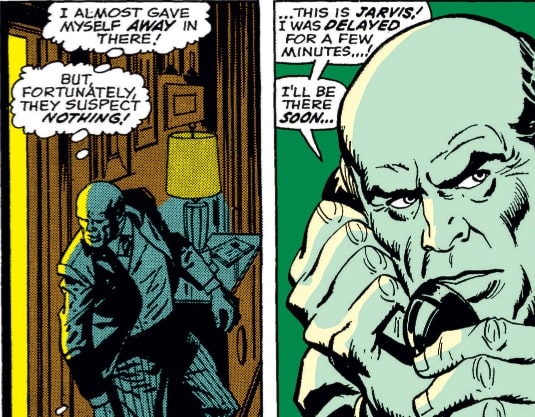
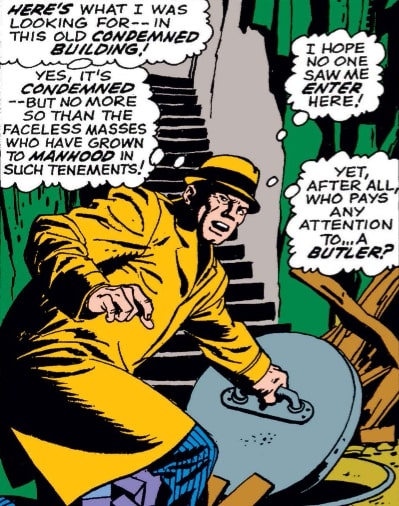
Specifically, he’s selling the Avengers to a new incarnation of the Masters of Evil.
We’ve already met Radioactive Man and Melter, and while I haven’t reviewed his first appearance we’ve seen Klaw plenty of times.
Completing the roster are Whirlwind (originating as a Giant-Man villain) and surprisingly enough the new Black Knight, who will join the Avengers soon.
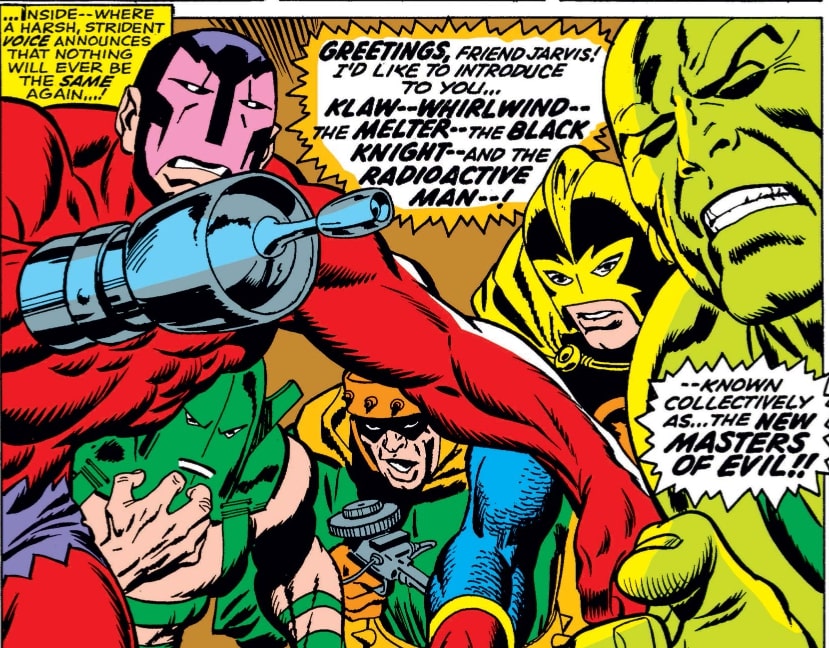
Leading the team is the mysterious Crimson Cowl, who’s never appeared before.
One of my typical complains about Roy Thomas is that he tends to make the solution about a mystery way too easy from the very beginning, but I’m absolutely certain NOBODY figured out the identity of Crimson Cowl.
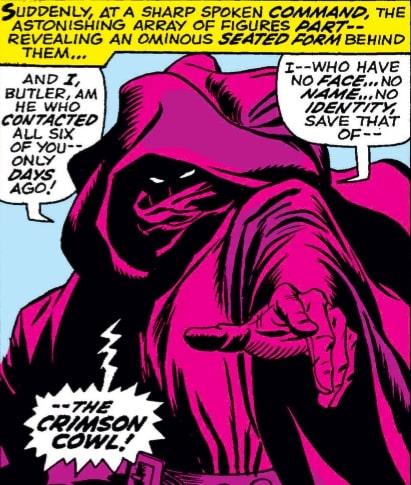
I’m not going to go into too much detail of issue #54, since I want to cover Crimson Cowl’s real identity in issue #55.
But what’s important is that he immediately knocks out Jarvis once he’s told the Masters of Evil how to get past the Avengers’ security measures.

Considering the eventual true identity of Crimson Cowl, it’s hilarious that he recruited Black Knight by sending him a letter!
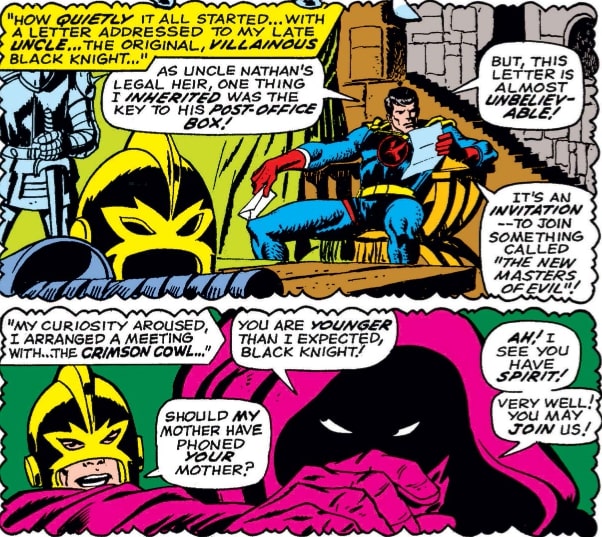
This Black Knight will prove to be FAR more popular than his villainous uncle, and he only pretended to join the Masters of Evil.
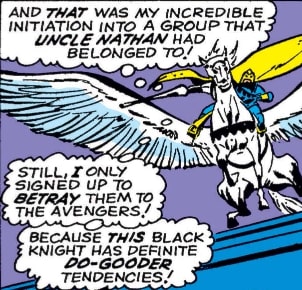
Unfortunately he’s still VERY inexperienced, and he doesn’t even have his trademark Ebony Blade yet… just a regular sword. So he ends up losing to the villains once they figure out he’s not one of them.

Long story short, the Masters of Evil manage to capture the entire team…

…and they discover that the Crimson Cowl that’s been giving them orders is actually a robot.

And the story ends with the shocking revelation that Crimson Cowl is actually Jarvis!
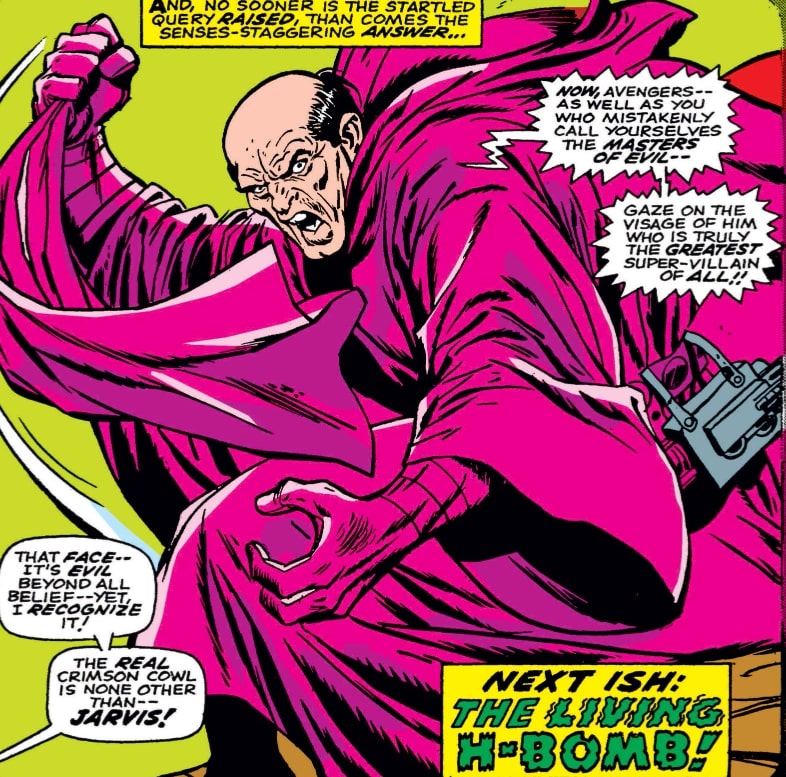
To be fair, someone MIGHT have figured out that Crimson Cowl was Jarvis… but once again, I’m sure nobody deduced who the REAL Crimson Cowl was.
AVENGERS #55 (1968)
by Roy Thomas & John Buscema
This is actually the first Avengers issue I ever read!
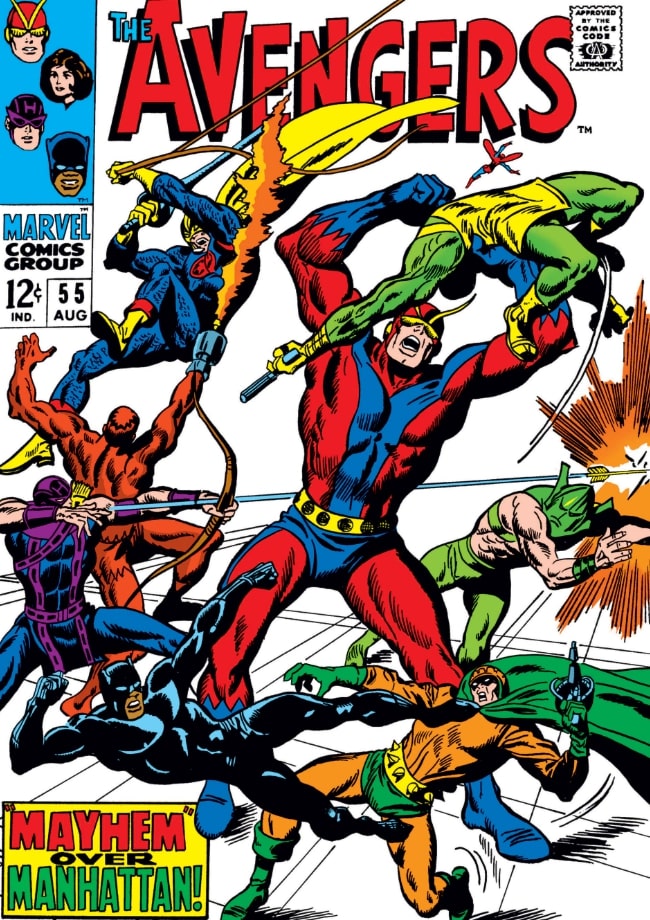
Klaw seriously needs a new hobby.
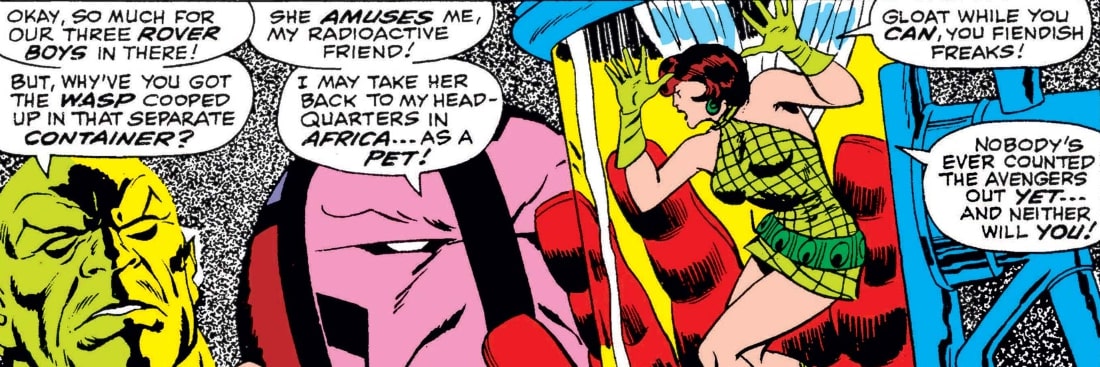
Radioactive Man brings up a valid point: why DON’T they kill the Avengers, since they were after revenge? You can thank the charisma of Crimson Cowl (and the fact that otherwise there would be no story).

It’s kind of a shame that the Crimson Cowl design will be dropped once we discover his identity, because John Buscema does a great job depicting him as a threatening presence.
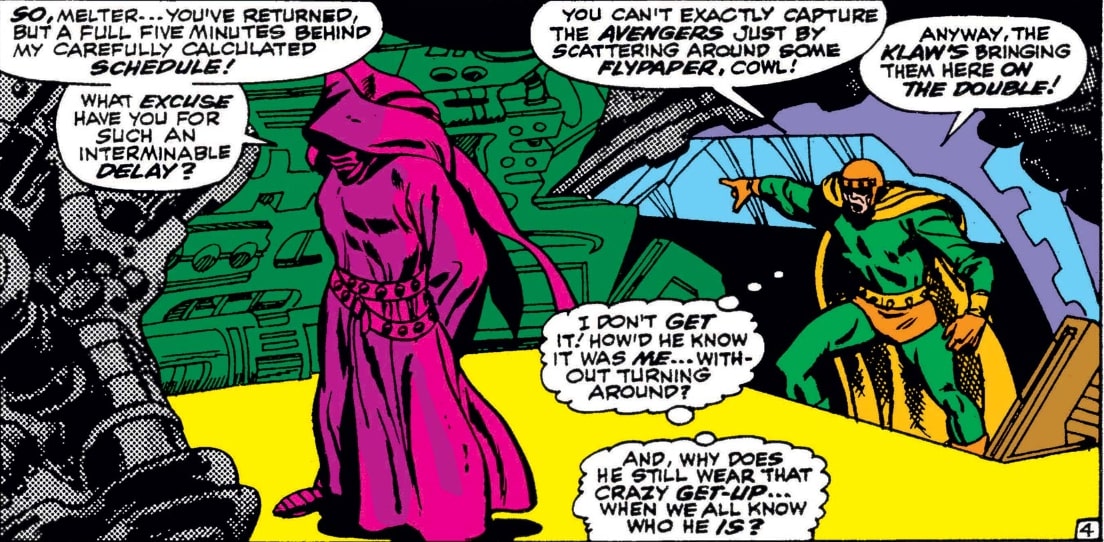
This is one of the most dysfunctional incarnations of the Masters of Evil, because it doesn’t take much before they start turning against their leader.
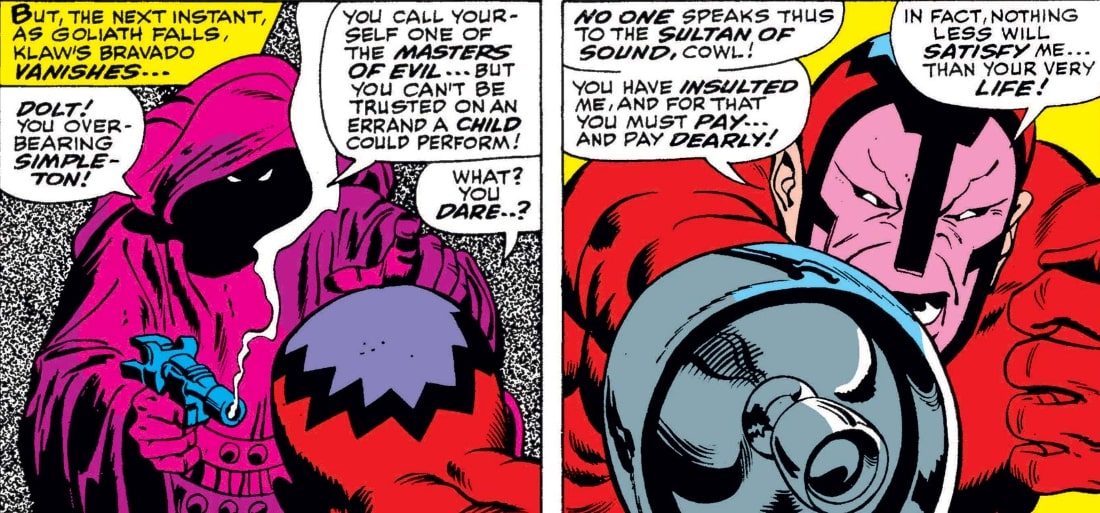
Crimson Cowl being able to completely ignore a full-power blast from Klaw is quite impressive. He doesn’t show it often, but Klaw is a real powerhouse.
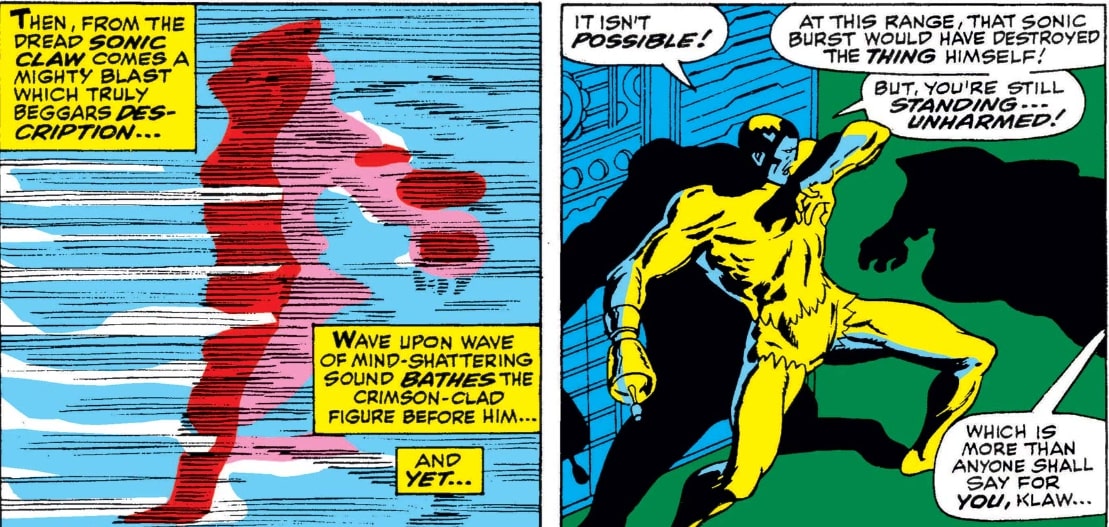
Not sure why he’s afraid of a gas gun, though. Did Thomas forget Klaw is made of solid sound (whatever the heck THAT means)?
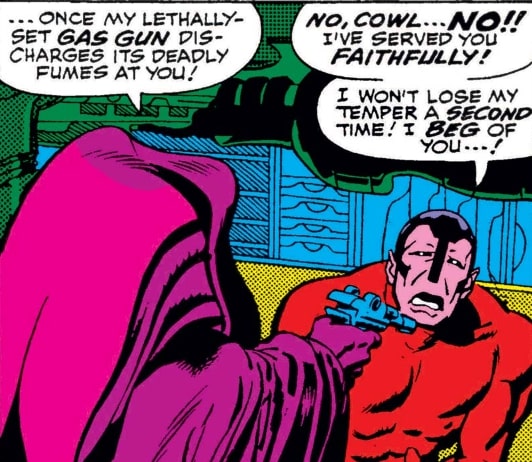
Crimson Cowl’s plan is to strap the Avengers to an hydrogen bomb (!!!) and then NUKE THE EMPIRE STATE BUILDING!!!

He then reveals that Jarvis didn’t REALLY betray the Avengers: he was just brainwashed.

And then we learn that Crimson Cowl really WAS that robot!
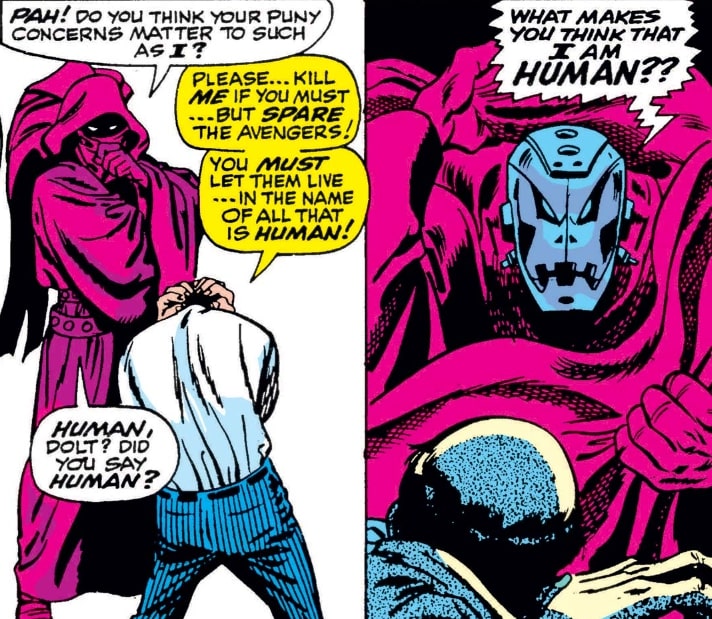
And THAT, ladies and gentlemen, is the introduction to Ultron.

His programming still needs some work, because he assigns the task of killing Jarvis to Melter.
Who, being Melter, naturally f##ks it up.
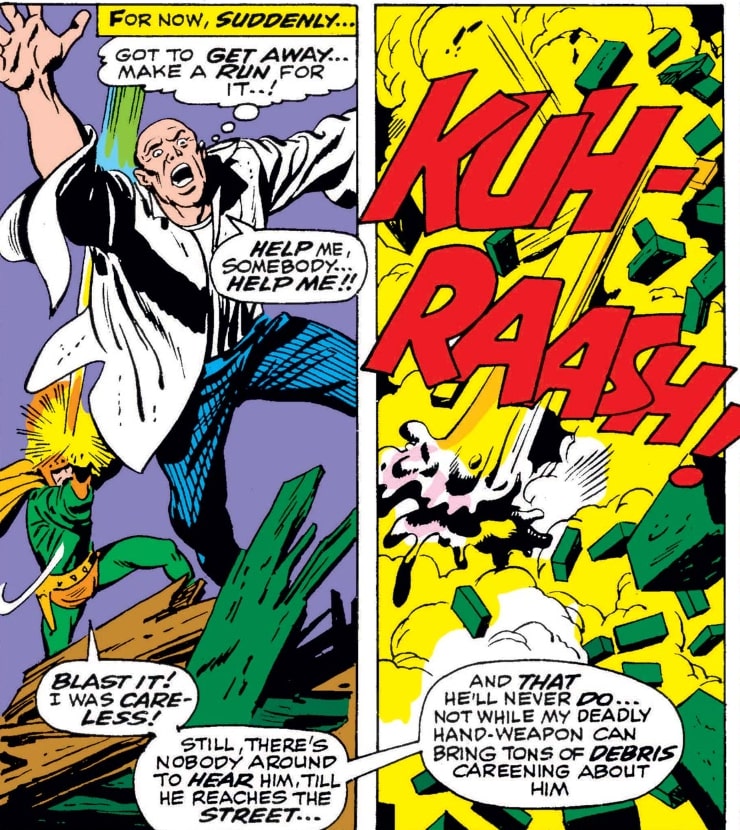
Jarvis BARELY survives, and in typical Marvel fashion the civilians he comes across are jackasses.
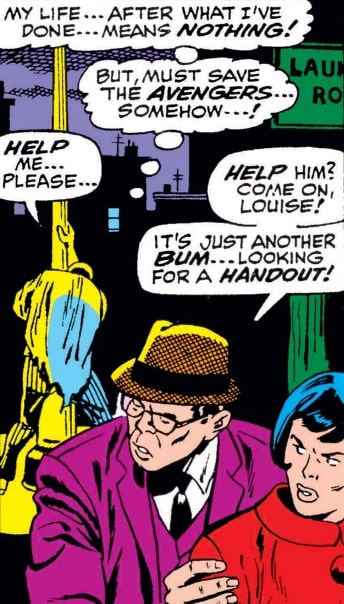
Thankfully he comes across Black Knight, who has been searching for the Avengers.
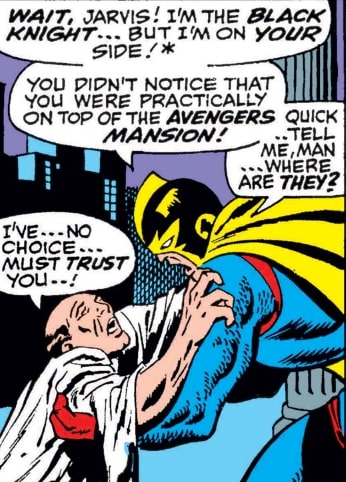
And so Black Knight catches up with the airship of the Masters of Evil on his flying horse, freeing the Avengers.
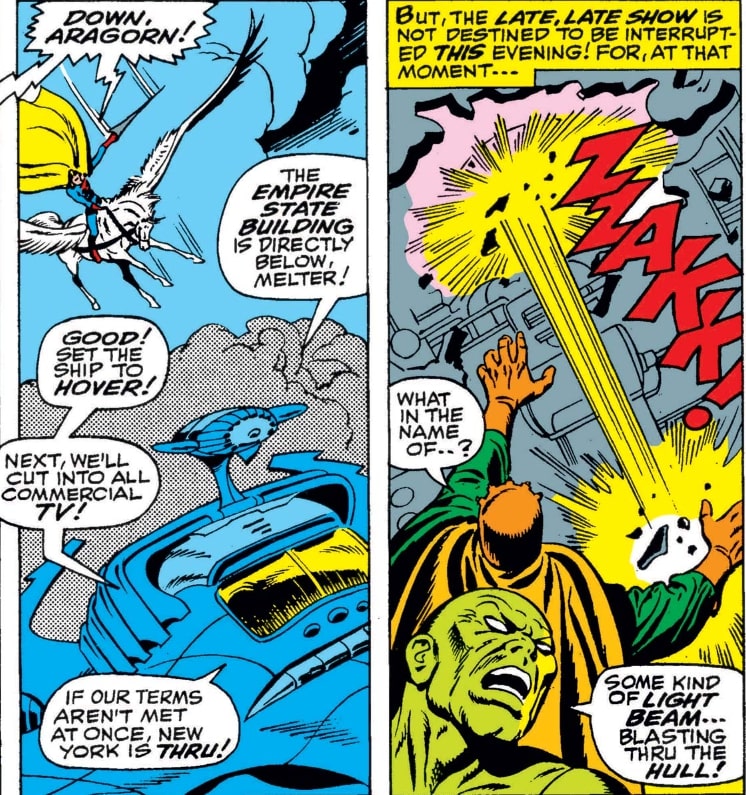
This does NOT make Ultron happy. No wonder he’ll mostly work alone from this point on.
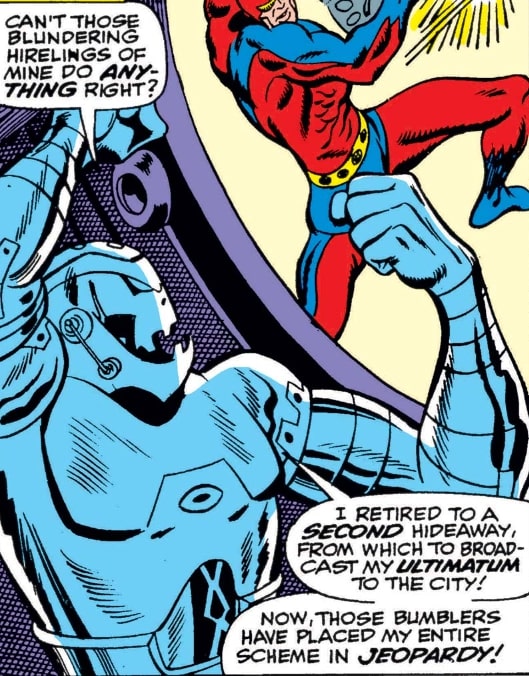
Without Ultron to call the shots, the Masters of Evil lose pretty badly.
Whirlwind is particularly embarrassing: he has super-speed, so Black Panther dodging him THAT easily is a bit of a stretch.
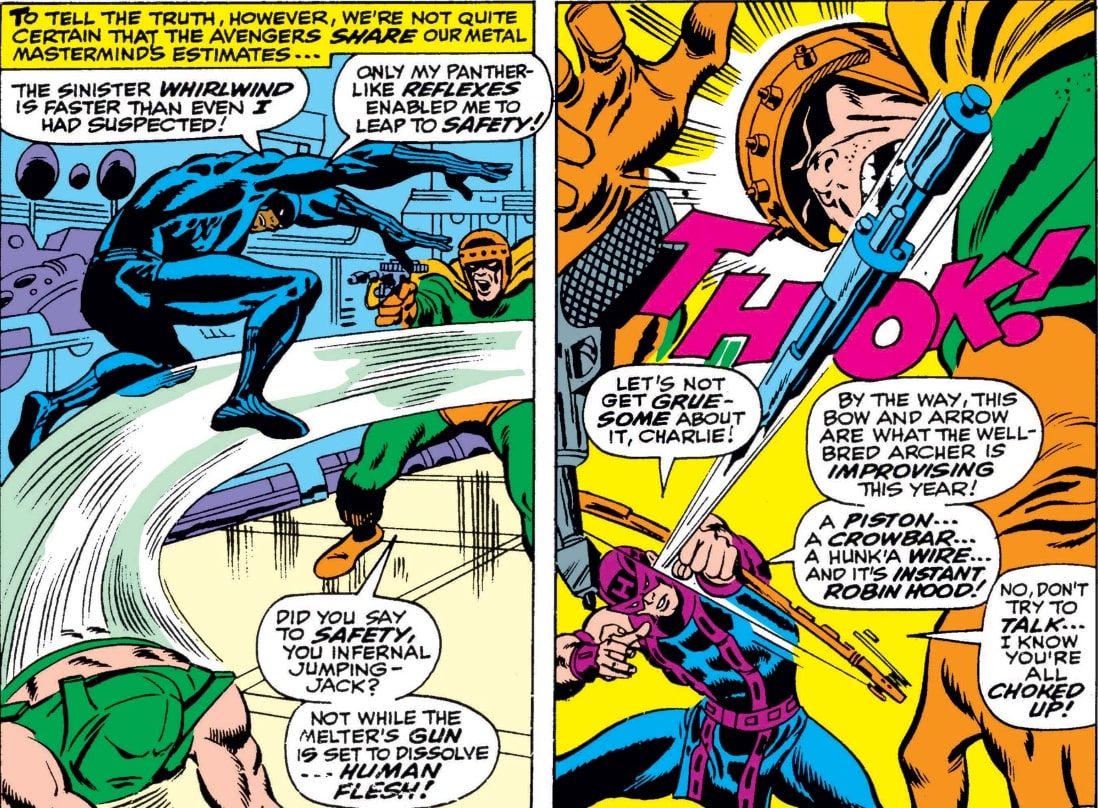
In the end, Jarvis is forgiven for his betrayal. The fact that he did it for the money doesn’t make much sense, and that’ll be fixed by Bob Harras years later (more on that soon).
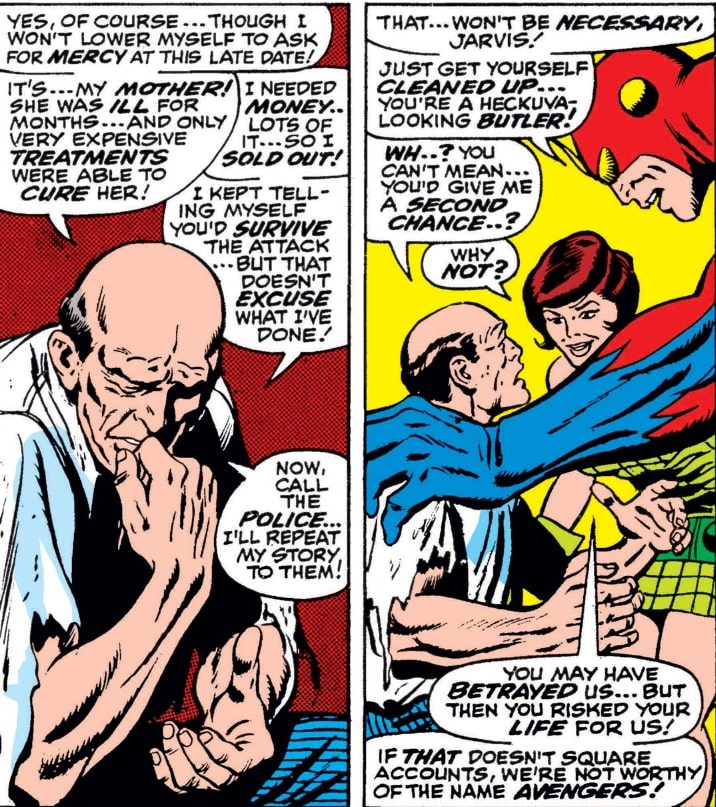
And that’s the end! The Avengers, or the readers for that matter, don’t even learn what Ultron is or why he hates the Avengers!!!
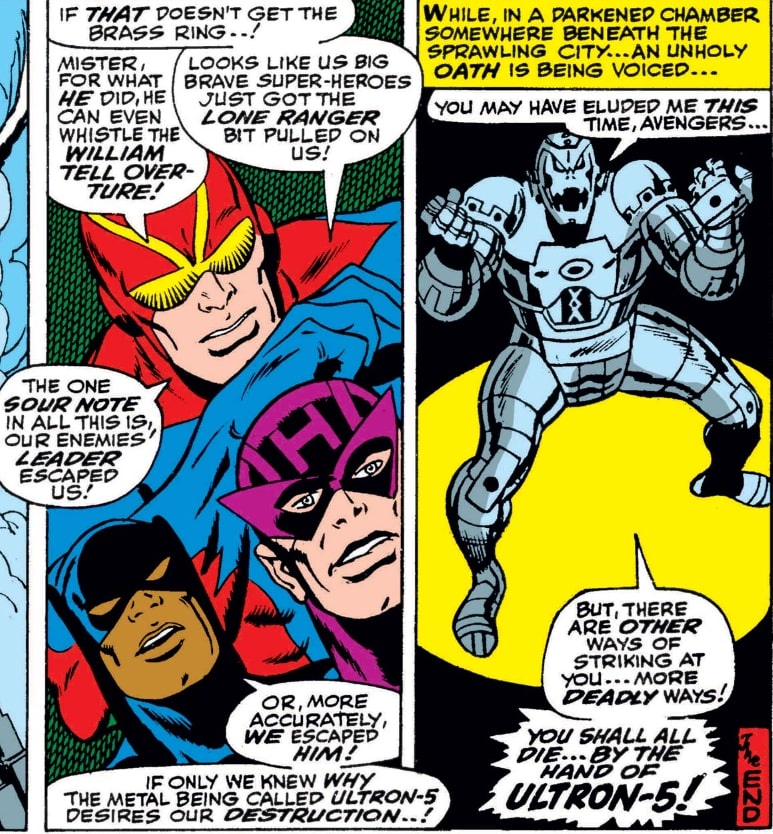
I’ll talk about Ultron soon, but I mentioned an issue with Jarvis.
Tony Stark has always been shown as nothing but very generous with his butler (he’s practically a member of the family), so the idea that Jarvis would result to crime to pay for his mother’s medical bills was kind of weird.
Until 1987, when Bob Harras fixed that in Avengers #280, revealing that Stark offered to pay for all medical expenses…

…but Ultron hypnotized him into not believing he’d do it.
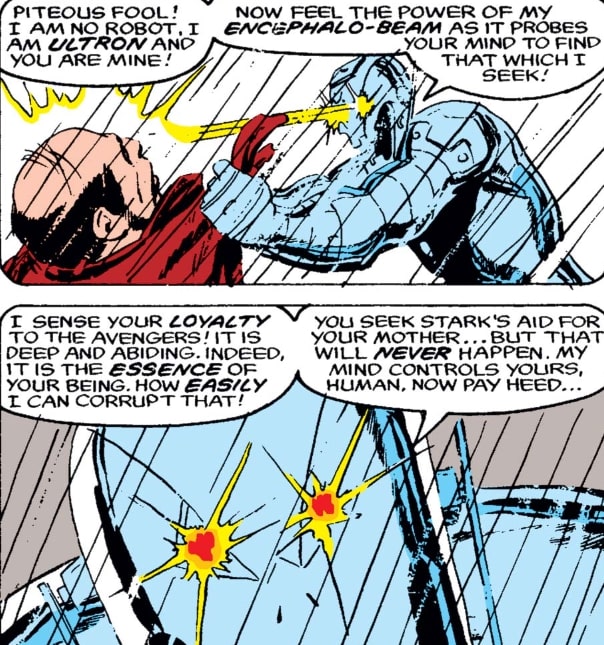
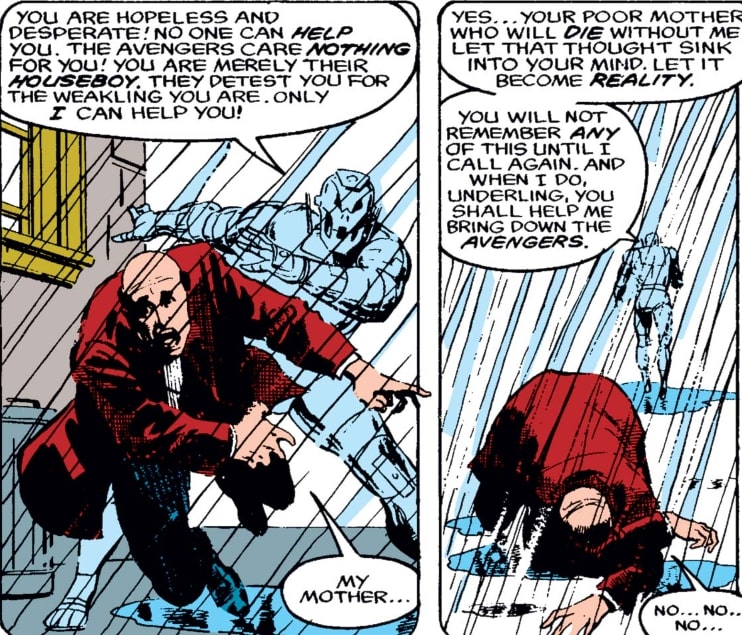
That was the issue where Jarvis, despite being severely wounded by Mr. Hyde and realizing working with the Avengers meant constantly risking his life… decided to return to duty without a second thought.
Because Jarvis is AWESOME.
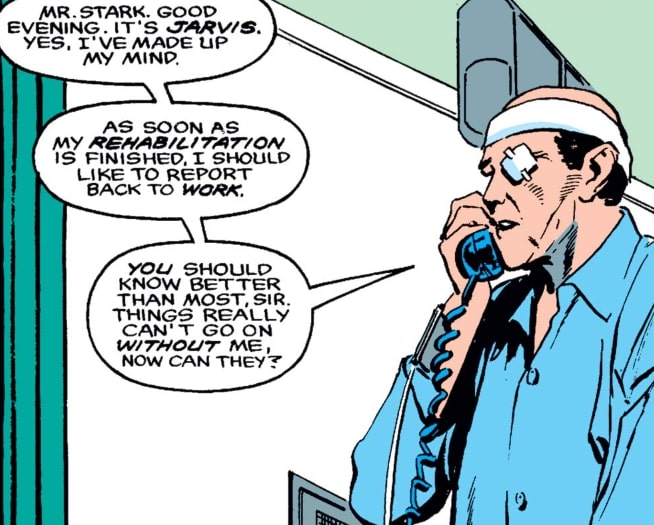
Historical significance: 7/10
Ultron is of course of massive importance. Kang is the only other possible candidate as the team’s arch-enemy, but with Ultron things are much more personal.
It’s still lower than expected because most of the typical Ultron characteristics won’t be introduced for a while (see below). It’s also an important issue for establishing Jarvis as a crucial part of the Avengers lore, and while Black Knight doesn’t join the team right away it’s still significant.
Silver Age-ness: 2/10
We have a robot coming out of nowhere, without explanation, who has a complicated plot involving pretending to be a butler.
Does it stand the test of time? 8/10
This is why I often find Roy Thomas frustrating to read: I know the guy can write an excellent story! And while his Avengers run doesn’t hit the mark 100% of the time, there’s still a ton of fantastic issues. The team has nice chemistry, the villain’s plot is complex but it’s not ridiculously overcomplicated, and obviously having John Buscema helps immensely.
You could never use today’s Ultron this way, but if you substitute him with any other similar character, this holds up remarkably well.
How close is this to the modern character? 5/10
Ultron took a while to evolve to his final form. He’s still a manipulator and he’s still fond of mind control, sure, but he’s not much of a physical threat and he’s not even bent on destroying human life… he just hates the Avengers here. That’s it.
Ultron will show up again 3 issues later, in the first Vision story.

That’s an AWESOME story. The ending stands out: after his defeat, Ultron’s head is found by a random kid… who throws it out like trash. All with a recitation of Ozymandias.
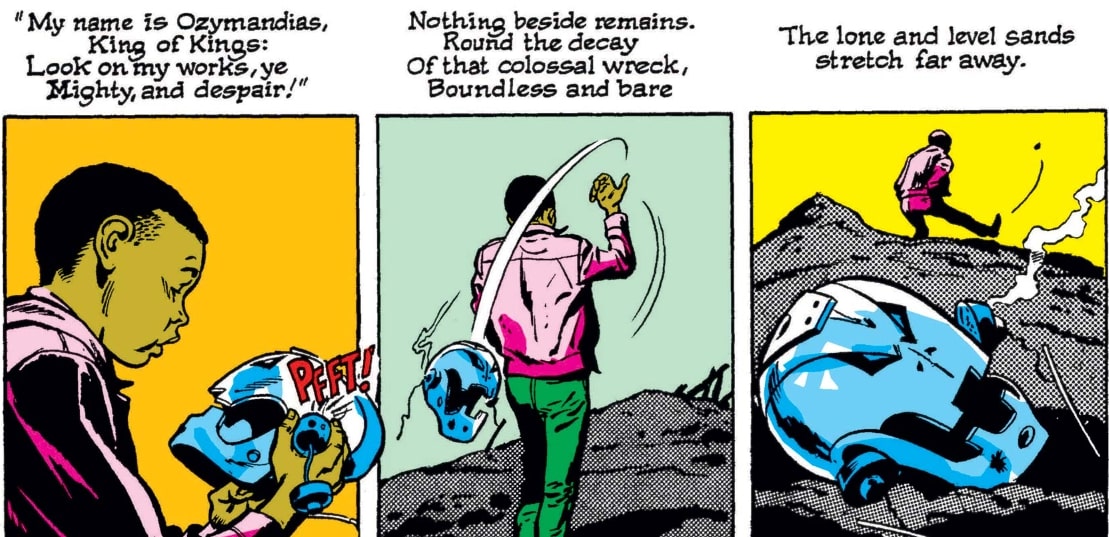
But we STILL had no idea of who Ultron was.
For that we’d have to wait the following issue, which included a flashback to Pym creating Ultron.

I’m kind of surprised a 1968 was allowed to mention the Oedipus Complex.
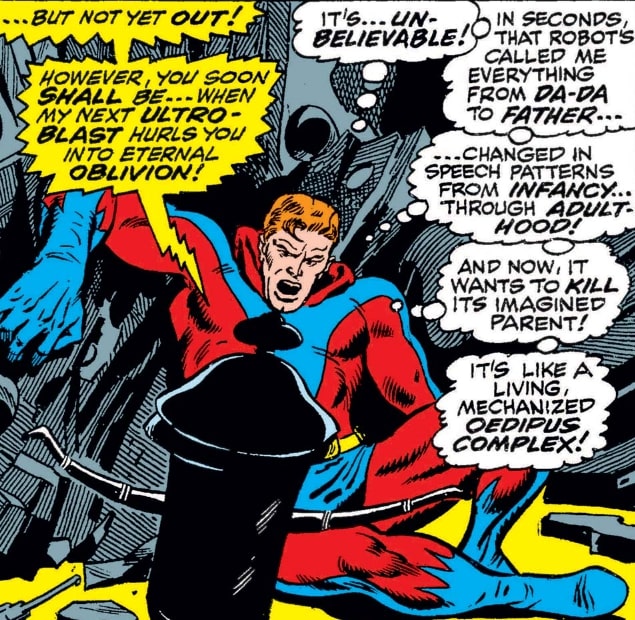
Ultron sure had a passion for mind control in this period.

But it’s Ultron’s next appearance in 1969 that would introduce several of his trademarks: his indestructible Adamantium™ body, him being powered by nuclear energy, and most importantly his omnicidal tendencies.
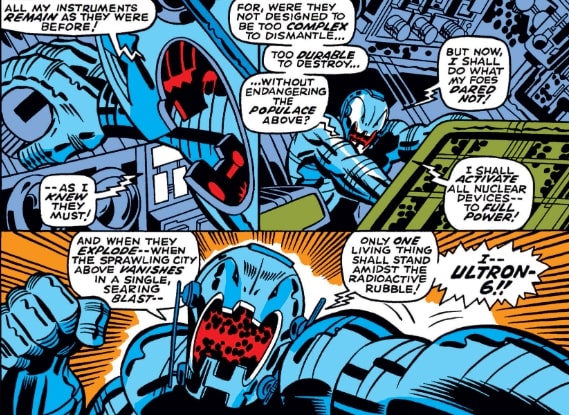
I always liked the fact that with every appearance Ultron would rebrand himself with a number. He debuted as Ultron-5 and went all the way up to Ultron-13 before the concept was abandoned.

He’s also one of the few supervillains to succeed in committing genocide, annihilating the fictional country of Slorenia in 1999.

So yeah, Ultron has gone from pretending to be a butler to being a menace so massive that whenever he shows up you need an entire superhero team to BARELY stay alive.

Ultron has never gone back to his Crimson Cowl identity, and we have no idea how he came up with the idea.
As I mentioned earlier the name has been used again, by a Thunderbolts villain, and there’s still a connection to the original since the new Crimson Cowl was still the leader of an incarnation of the Masters of Evil.
There’s a very slight difference from the original, though. See if you can spot it.
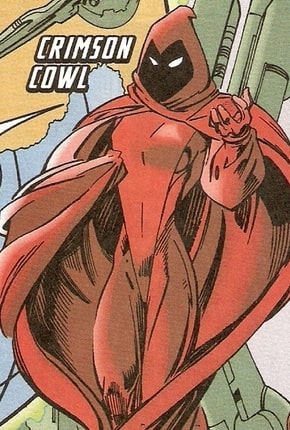

I enjoy your posts and commentaries immensely… thank you and keep up the outstanding work!
Ultron is one of those villains that gets better with age, like a fine wine.
Ultron-5: Breakable robot, needs a gas gun, needs a villain group, no motivations (other than “hates the Avengers”, for some reason.)
Ultron-later: Builds the Vision as a catspaw, indestructible adamantium body, Oedipus complex against Hank Pym.
Ultron-Busiek: Realises any ally or catspaw is unreliable, so builds hundreds of copies of itself for its army; has graduated from “kill the Avengers” to “kill all humanity.”
Ultron graduated to “kill all humans” a bit earlier, I believe in West Coast Avengers, but other than that 100% agree.
Earlier than that, definitely. Ultron-11 (the version who appeared in Secret Wars) wanted to kill all organic life.
Did Roy Thomas not know that Radioactive Man was a Chinese scientist? He sure didn’t write him like one anywhere in this story – at one point he calls Jarvis “Fancy Pants,” refers to something as being out of left field, and casually drops a Rover Boys reference, which I’m not sure even many American readers would’ve gotten in the 60s, let alone a Chinese citizen.
I guess the upside is that means there’s no attempt at stereotypical comic book Chinese dialect, but it definitely makes Radioctive Man’s dialogue here sound weird in the context of the character.
Yeah, even when Roy Thomas writes a good story, it still has Roy Thomas dialogue.
Please do a retrospective on the All Star Squadron. Roy Thomas had a pretty good run on that comic. And they had some gem story arcs.
I might eventually review some individual stories that are historically significant.
A full Metal Men-style retrospective is not really feasible, there’d be WAY too much stuff to cover.